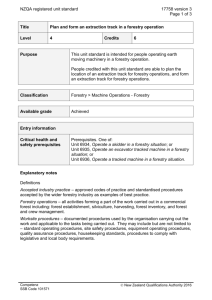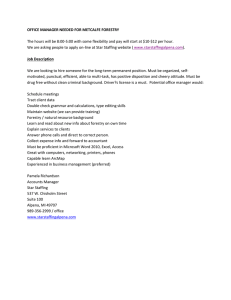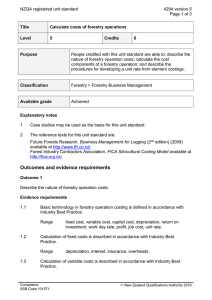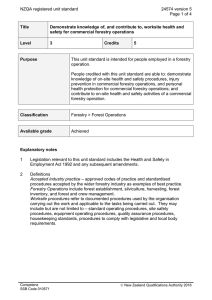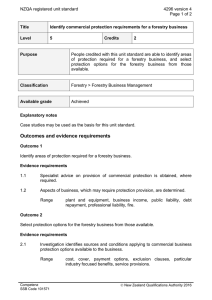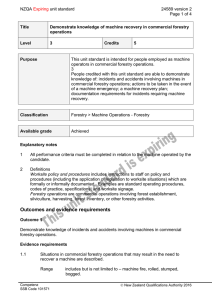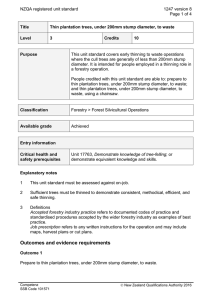NZQA registered unit standard 1230 version 7 Page 1 of 3
advertisement
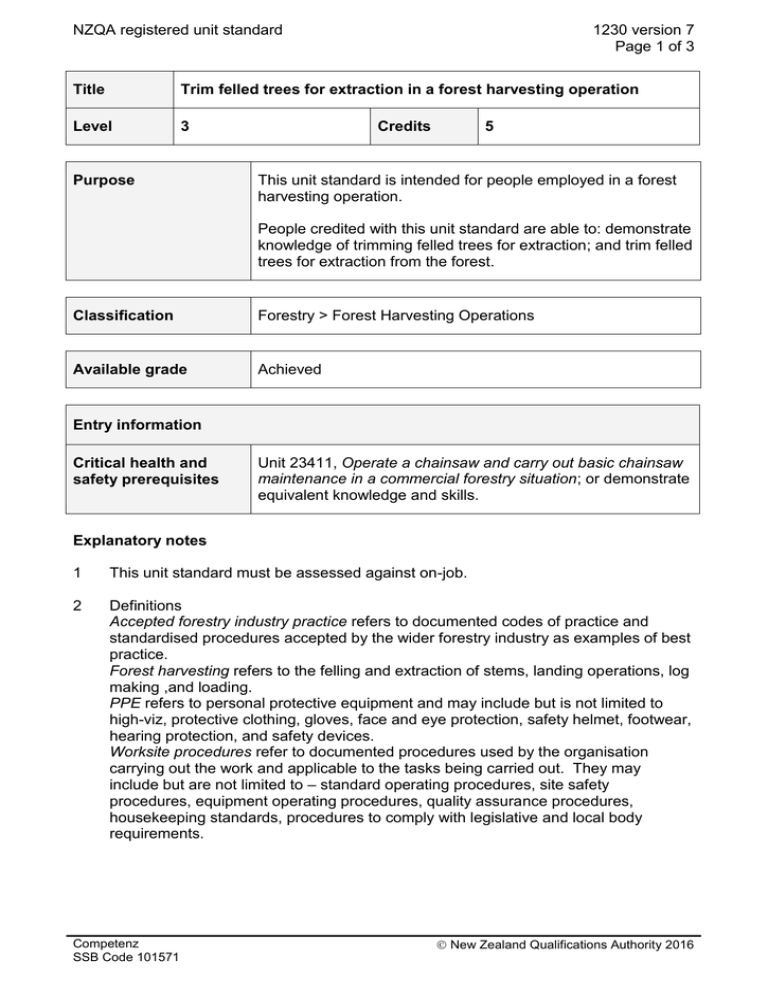
NZQA registered unit standard 1230 version 7 Page 1 of 3 Title Trim felled trees for extraction in a forest harvesting operation Level 3 Purpose Credits 5 This unit standard is intended for people employed in a forest harvesting operation. People credited with this unit standard are able to: demonstrate knowledge of trimming felled trees for extraction; and trim felled trees for extraction from the forest. Classification Forestry > Forest Harvesting Operations Available grade Achieved Entry information Critical health and safety prerequisites Unit 23411, Operate a chainsaw and carry out basic chainsaw maintenance in a commercial forestry situation; or demonstrate equivalent knowledge and skills. Explanatory notes 1 This unit standard must be assessed against on-job. 2 Definitions Accepted forestry industry practice refers to documented codes of practice and standardised procedures accepted by the wider forestry industry as examples of best practice. Forest harvesting refers to the felling and extraction of stems, landing operations, log making ,and loading. PPE refers to personal protective equipment and may include but is not limited to high-viz, protective clothing, gloves, face and eye protection, safety helmet, footwear, hearing protection, and safety devices. Worksite procedures refer to documented procedures used by the organisation carrying out the work and applicable to the tasks being carried out. They may include but are not limited to – standard operating procedures, site safety procedures, equipment operating procedures, quality assurance procedures, housekeeping standards, procedures to comply with legislative and local body requirements. Competenz SSB Code 101571 New Zealand Qualifications Authority 2016 NZQA registered unit standard 1230 version 7 Page 2 of 3 Outcomes and evidence requirements Outcome 1 Demonstrate knowledge of trimming felled trees for extraction. Evidence requirements 1.1 Hazards associated with trimming felled trees are identified and a method for managing each hazard is explained in accordance with relevant worksite procedures and accepted forestry industry practice. Range hazards may include but are not limited to – tree movement, branches/stem under tension, chainsaw kickback, proximity of extraction machine, ground conditions, slope of the ground, undergrowth, slash, continuous bending; evidence of five hazards is required. 1.2 The reason for on-going hazard identification is explained in accordance with accepted forestry industry practice. 1.3 Factors that may change hazards or introduce new hazards are described in accordance with accepted forestry industry practice. Range 1.4 Trimming methods are described in terms of sequence of cuts in accordance with accepted forestry industry practice. Range 1.5 weather, terrain, fatigue. lever limbing method, large branches. Rules specific to trimming are described in accordance with accepted forestry industry practice. Outcome 2 Trim felled trees for extraction from the forest. Evidence requirements 2.1 Equipment to be used meets the requirements of the operation in accordance with worksite procedures and accepted forestry industry practice. Range 2.2 PPE, chainsaw, fuel storage, first aid. Felled trees are assessed prior to and during trimming and heading in accordance with accepted forestry industry practice and worksite procedures. Range Competenz SSB Code 101571 hindrance, compression, tension, possible stem movement. New Zealand Qualifications Authority 2016 NZQA registered unit standard 2.3 1230 version 7 Page 3 of 3 Trees are trimmed and headed in preparation for extraction in accordance with accepted forestry industry practice and worksite procedures. Planned review date 31 December 2020 Status information and last date for assessment for superseded versions Process Version Date Last Date for Assessment Registration 1 28 January 1995 31 December 2012 Review 2 8 November 1996 31 December 2012 Revision 3 19 June 1998 31 December 2012 Review 4 5 December 2000 31 December 2012 Review 5 22 May 2008 31 December 2012 Review 6 16 October 2009 31 December 2016 Review 7 19 March 2015 N/A Consent and Moderation Requirements (CMR) reference 0173 This CMR can be accessed at http://www.nzqa.govt.nz/framework/search/index.do. Please note Providers must be granted consent to assess against standards (accredited) by NZQA, before they can report credits from assessment against unit standards or deliver courses of study leading to that assessment. Industry Training Organisations must be granted consent to assess against standards by NZQA before they can register credits from assessment against unit standards. Providers and Industry Training Organisations, which have been granted consent and which are assessing against unit standards must engage with the moderation system that applies to those standards. Requirements for consent to assess and an outline of the moderation system that applies to this standard are outlined in the Consent and Moderation Requirements (CMR). The CMR also includes useful information about special requirements for organisations wishing to develop education and training programmes, such as minimum qualifications for tutors and assessors, and special resource requirements. Comments on this unit standard Please contact Competenz qualifications@competenz.org.nz if you wish to suggest changes to the content of this unit standard. Competenz SSB Code 101571 New Zealand Qualifications Authority 2016
